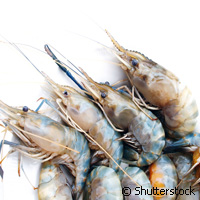Shrimp farming feels viral impact
White spot syndrome virus (WSSV) has a devastating impact on shrimp farming throughout the world, becoming more aggressive as the epidemic spreads, contrary to other viruses like flu that gradually die out. Scientists from Wageningen University in the Netherlands discovered that WSSV evolves when shrimp farming practices are adapted. They hope that greater understanding will allow further control and containment of the disease. The findings were recently published in the journal PLoS ONE. Global shrimp production has tripled over the past decade from 750,000 tonnes in the 1990s to more than 3 billion tonnes in the last 5 years, severely affecting coastal ecosystems and livelihoods. WSSV is a deadly pathogen for shrimp, and has been a major threat to shrimp farming for the last two decades, according to the researchers. The disease is highly lethal and contagious killing shrimps quickly. Outbreaks of WSSV have wiped out within a few days the entire populations of shrimp farms throughout the world. Over time the virus has manifested itself more severely; documented outbreaks in China in 1992 and in Ecuador in 1999 showed a 70% drop in local shrimp production following the outbreaks. The virus has since spread globally and has even been found in wild crustaceans in Europe. In order to discover why WSSV behaves so differently to other viruses, the Wageningen scientists reconstructed the genetic and geographical trajectory of the shrimp virus from the putative ancestral source. They discovered that the fitness of the virus increases over time and the genome shrinks, in a pattern similar to theoretical predictions from evolutionary biology. The scientists, led by Dr Mark Zwart from the university's Laboratory of Virology, first analysed samples of the virus in shrimps from five Asian countries then compared them to each other and published literature on WSSV from China, Taiwan, Thailand and Vietnam. This helped the authors identify which genetic and fitness changes emerged in the various virus populations since WSSV was first discovered. They found that the large genome of the WSSV virus has regions that vary among isolates, which mainly distinguish themselves by missing DNA (deoxyribonucleic acid) fragments, or so-called deletions. By lining up a time series of virus samples, the scientists said they identified a remarkable pattern; namely that the majority of these variable regions disappeared from the genome initially, but that the deletion rate decreased over time in a process that could be mathematically described. Tests with shrimp showed that the virulence of the virus increased accordingly. Both changes appear to be evolutionary adaptations of the virus to the shrimp farming practices, according to the team. The virus also seems to have spread over long distances within a short time, suggesting that the transportation of infected shrimps is a factor. Preventing the virus from spreading is a major area of improvement in fighting future virus outbreaks in shrimp production systems, said the researchers, underlining the need for intervention strategies to focus on long-range transport. They highlighted that, for example, strict measures were in place in the Philippines to stop the entrance of WSSV, preventing the establishment of the virus until 1999. Restriction measures in the Philippines included a prohibition on the import of all exotic shrimp species and regulation of the within-country movement of shrimp fry. The scientists said they hoped that a better understanding of the epidemiology of WSSV at different temporal and spatial scales would lead to further control and containment of the disease.
Countries
Netherlands



